New Mexico Space History Museum
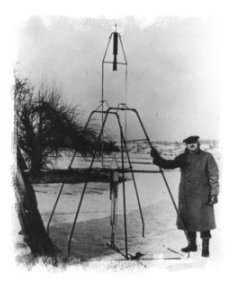 It can be argued that modern rocketry was invented in New Mexico. Robert Goddard, the inventor of the liquid fueled rocket, did the bulk of his groundbreaking experimentation at Roswell, NM. Goddard’s work was later used by Werner Von Braun in his designs for the German V-1 and V-2 rockets. After WWII, Von Braun came to the US and was instrumental in the US Space program, eventually designing the Saturn V rockets that would take the Apollo spacecraft to the moon and back.
It can be argued that modern rocketry was invented in New Mexico. Robert Goddard, the inventor of the liquid fueled rocket, did the bulk of his groundbreaking experimentation at Roswell, NM. Goddard’s work was later used by Werner Von Braun in his designs for the German V-1 and V-2 rockets. After WWII, Von Braun came to the US and was instrumental in the US Space program, eventually designing the Saturn V rockets that would take the Apollo spacecraft to the moon and back.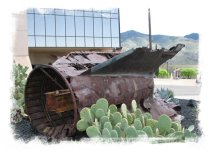 The rusted out shell of a V-2 lies in the courtyard of the New Mexico Space History Museum. After the war, the US brought dozens of captured V-2s from Germany to White Sands Proving Grounds (now White Sands Missile Range). There the V-2’s were studied and test fired, gaining the US valuable expertise in rocketry. One of these V-2’s (perhaps the one at the museum) malfunctioned and went off course, crash landing on the hillside above Alamogordo, just behind where the Space Museum stands today!
The rusted out shell of a V-2 lies in the courtyard of the New Mexico Space History Museum. After the war, the US brought dozens of captured V-2s from Germany to White Sands Proving Grounds (now White Sands Missile Range). There the V-2’s were studied and test fired, gaining the US valuable expertise in rocketry. One of these V-2’s (perhaps the one at the museum) malfunctioned and went off course, crash landing on the hillside above Alamogordo, just behind where the Space Museum stands today!The Musuem (which contains the International Space Hall of Fame) is a striking building sitting above the town. In the afternoons, the glass windows reflect a deep gold color – a sight we saw all the way from the White Sands National Monument, nearly 20 miles away. Buried in front of the Museum is Ham, the worlds first ‘astrochimp’.
The museum is a little dated, but it didn’t really matter, as it was quite interesting. Vance has recently taken an interest in the space program as a result of us viewing “Apollo 13”. I enjoyed pointing out to him mock ups of Sputnik and Explorer (the first US satellite). I also spent some time explaining to him and Denise the mechanics of how the components of the Apollo flights worked – the command module, Service module, lunar excursion module (LEM), etc…..
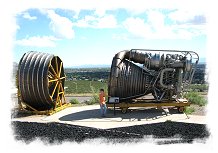 The museum had examples of the various rocket engines used in the Apollos, from one of the F-1 engines used in the first stage booster of a Saturn V rockets (it was huge, and there were five of them in the first stage), to the small 100 lb thrust engines used for maneuvering the command/service module around. Vance enjoyed seeing the pictures of the actual astronauts on Apollo 13.
The museum had examples of the various rocket engines used in the Apollos, from one of the F-1 engines used in the first stage booster of a Saturn V rockets (it was huge, and there were five of them in the first stage), to the small 100 lb thrust engines used for maneuvering the command/service module around. Vance enjoyed seeing the pictures of the actual astronauts on Apollo 13.We’ve been listening to a series of physics lectures while on long drives, and one of them concerned the amount of thrust it took to escape earth’s gravity well. It was interesting to contrast the thrusts of the various rocket engines – the first stage of a Saturn V rocket put out 7.5 million pounds of thrust. In contrast, the engine used to lift the LEM from the moon’s surface only put out 3,500 lbs of thrust! This dramatically highlighted the differences in the force of gravity that must be overcome, and why it costs so much to put something in space. I calculated one time that it takes about 30 pounds of fuel to put one pound of payload into orbit.
Another interesting tidbit was the fuel used in the Saturn rockets – Liquid oxygen, and Kerosene. We went to the moon on the same stuff used to light Coleman stoves!
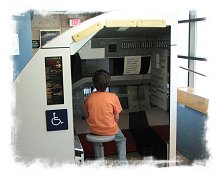 Vance’s favorite exhibit was a simulator for landing the Space Shuttle. It was well done, and not at all easy. I came in on target a couple of times, but pancaked at the very end when I didn’t flair up the nose properly before touching down. Vance would still be there playing if we didn’t make him leave!
Vance’s favorite exhibit was a simulator for landing the Space Shuttle. It was well done, and not at all easy. I came in on target a couple of times, but pancaked at the very end when I didn’t flair up the nose properly before touching down. Vance would still be there playing if we didn’t make him leave!Probably the most interesting moment was the gentleman that followed me on the simulator. He turned out to be one of the frogmen that helped Alan Sheppard out of his capsule on the first Mercury flight. He later became a pilot, and had no problem landing the shuttle on his first simulation try! I wish I’d thought of getting an autograph, and I tried to explain to Vance why Alan Shepard’s flight was important (it was the first U.S. manned flight).
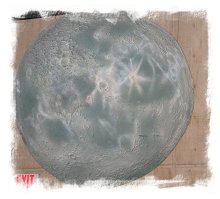 There were several other displays I thought were noteworthy. One was a half moon disk that was used a a backdrop by Walter Cronkite during the Apollo 13 broadcasts. Another interesting display was a series of transparent satellite mock ups. You never get to see what is inside the satellite packages, and this helped me understand just what all went inside of them.
There were several other displays I thought were noteworthy. One was a half moon disk that was used a a backdrop by Walter Cronkite during the Apollo 13 broadcasts. Another interesting display was a series of transparent satellite mock ups. You never get to see what is inside the satellite packages, and this helped me understand just what all went inside of them.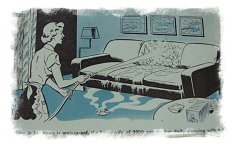 A final display Denise and I both enjoyed was called “Yesterdays Tomorrows’. These displayed ads, pictures and stories from the 40’s and 50’s, predicting what things would be like today. It was pretty funny. My favorite was a woman hosing down her living room to clean it, ‘as furniture would all be made of waterproof material!’
A final display Denise and I both enjoyed was called “Yesterdays Tomorrows’. These displayed ads, pictures and stories from the 40’s and 50’s, predicting what things would be like today. It was pretty funny. My favorite was a woman hosing down her living room to clean it, ‘as furniture would all be made of waterproof material!’On the bottom level was a section devoted to the X-Prize, recently won by Spaceship One. The X-Prize is a $10 million award to the first spacecraft that could reach an altitude of 100km above the earth, and repeat the flight inside of 2 weeks. The X Prize foundation and the State of New Mexico have joined together to sponsor the X-Prize Cup, an annual rocket competition. It will be held in October, and looked rather interesting.

There was a display on the various competitors for the initial X-Prize. I had an interesting time looking at all the various approaches. One of the most innovative involved lifting the spacecraft to a level of 25,000 ft using a balloon. The winning entry flew Spaceship One up to a similar height piggyback on the ‘White Knight’, a plane built specially for that purpose. This initial height gain saves a tremendous amount of fuel, as the first 5 miles of lift (and the ones with the most gravity to fight) are avoided.
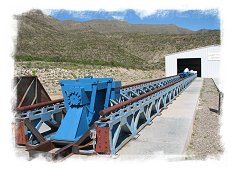 The US did not have any good data on what type of G-forces humans could tolerate . In order to develop systems needed for spaceflight and the G-forces that would be experienced (1 G equals the pull of gravity at sea level – bottoming out on roller coaster is about 3-4 G’s) some type of testing needed to be done. The response to this need was the Daisy track. A volunteer would be strapped onto a sled on rails, and then the sled was launched using a mechanism similar to what is used to launch planes from an aircraft carrier. The sled then slams into a water break, stopping it immediately. This action generates a very high G force, if only for a short time. One of the volunteers went as high as 80 G’s. Data gathered from these tests was used to develop the seats for the astronants, as well as leading to design of seatbelts. The original crash test dummies were used in Daisy Track testing also.
The US did not have any good data on what type of G-forces humans could tolerate . In order to develop systems needed for spaceflight and the G-forces that would be experienced (1 G equals the pull of gravity at sea level – bottoming out on roller coaster is about 3-4 G’s) some type of testing needed to be done. The response to this need was the Daisy track. A volunteer would be strapped onto a sled on rails, and then the sled was launched using a mechanism similar to what is used to launch planes from an aircraft carrier. The sled then slams into a water break, stopping it immediately. This action generates a very high G force, if only for a short time. One of the volunteers went as high as 80 G’s. Data gathered from these tests was used to develop the seats for the astronants, as well as leading to design of seatbelts. The original crash test dummies were used in Daisy Track testing also.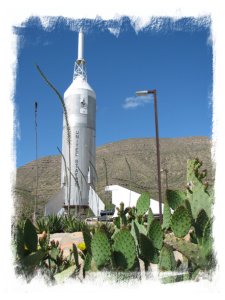 Outside the museum was a variety of missiles, and a Joe II rocket. The Joe II was a single stage booster used to simulate the launch path of the first stage of a Saturn V rocket. The Joe II was used to test the emergency evacuation system for the Apollos. On top of the command module was a small rocket booster that would separate the command module from the rest of the rocket in case of an emergency, allowing it to land using the normal parachute system. There was also a mockup of a Mercury capsule that Vance loved playing in.
Outside the museum was a variety of missiles, and a Joe II rocket. The Joe II was a single stage booster used to simulate the launch path of the first stage of a Saturn V rocket. The Joe II was used to test the emergency evacuation system for the Apollos. On top of the command module was a small rocket booster that would separate the command module from the rest of the rocket in case of an emergency, allowing it to land using the normal parachute system. There was also a mockup of a Mercury capsule that Vance loved playing in.
Vance: The Space Museum has many exhibits about space history. At the beginning there were artifacts about the first satellites launched into space. There were also plaques on the walls about people who helped lead and travel into space. There was a soundboard about how certain rockets sounded when they took off.
We got to play a little game about landing a space shuttle. I tried the game at least 5 times, but it was very hard. Later we went to check out a Mercury Capsule. A Mercury Capsule was a small capsule that the first astronauts used. Outside the museum there were some old missiles and rockets.
THERE WERE THREE MAJOR SPACESHIP PROGRAMS,THE MERCURY, THE GEMINI, AND THE APOLLO!
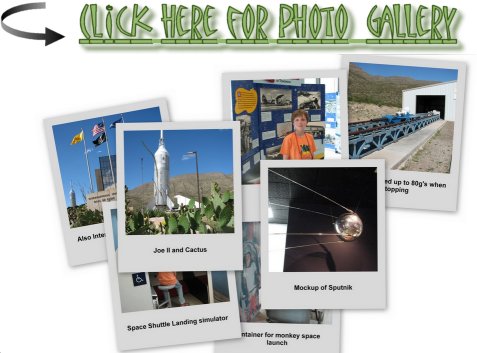
| Prev - Houston, we have a... | | Home | Index | | Sledding in the Desert - Next |







<< Home